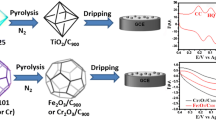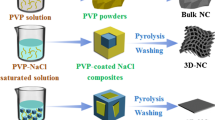Abstract
It is needed to speed up the development of a sensitive detection platform for simultaneous determination of dihydroxybenzene isomers with harmful properties. Here, two isomorphic Metal–organic frameworks (MOFs) [Zn(Trz)(R-BDC)1/2] (FJU-40-R, R = H or NH2; Trz = 1,2,4-Triazole; H-BDC = terephthalic acid) were selected to derive two N-doping porous carbon (NPC) materials. Further, a strategy for constructing electrochemical sensors for simultaneous determination of hydroquinone (HQ) and catechol (CT) was proposed by the MOF-derived NPC modifying glass carbon electrode (GCE). It was found that HQ and CT had good responses on NPC-FJU-40-H/GCE, but had no obvious responses on NPC-FJU-40-NH2/GCE. NPC-FJU-40-H/GCE displayed excellent reproducibility, stability, and anti-interference. Under the optimal conditions, the linear ranges of HQ and CT on NPC-FJU-40-H/GCE were 1 ~ 70 µmol L−1 and 1 ~ 100 µmol L−1 with the detection limits of 0.18 µmol L−1 for HQ and 0.31 µmol L−1 for CT, respectively. Although the porous carbon (PC) derived from MOFs has been applied in electrochemical sensing, the effect of the ligand functional groups of isomorphic MOFs on the electrochemical properties of the derived PC materials is still lack of relevant research. Our research provided an idea that the electrocatalysis properties of MOF-derived porous carbon materials could be tuned by changing the functional groups in ligands of isomorphic MOFs in electrochemical sensing field.
Graphical abstract
A feasible strategy was proposed by changing the ligands of the two isomorphic MOFs (FJU-40-H and FJU-40-NH2) to tune the electrocatalysis properties of MOF-derived N-doped porous carbon materials for the simultaneous determination of dihydroxybenzene isomer.









Similar content being viewed by others
References
Subramoney S (1998) Novel nanocarbons-structure, properties, and potential applications. Adv Mater 10:1157–1171
Kyotani T (2000) Control of pore structure in carbon. Carbon 38:269–286
Lee G, Pyun S (2007) Synthesis and characterization of nanoporous carbon and its electrochemical application to electrode material for supercapacitors. Mod Aspects Electrochem 2007 41(39):139–195
Gao Y, Yue Q, Xu S et al (2015) Preparation and evaluation of adsorptive properties of micro-mesoporous activated carbon via sodium aluminate activation. Chem Eng J 274:76–83
Jain A, Balasubramanian R, Srinivasan MP (2015) Production of high surface area mesoporous activated carbons from waste biomass using hydrogen peroxide-mediated hydrothermal treatment for adsorption applications. Chem Eng J 273:622–629
Zubrik A, Matik M, Hredzák S et al (2017) Preparation of chemically activated carbon from waste biomass by single-stage and two-stage pyrolysis. J Clean Prod 143:643–653
Rodriguez Mirasol J, Cordero T, Radovic LR et al (2012) Structural and textural properties of pyrolytic carbon formed within a microporous zeolite template. Chem Mater 10:550–558
Zhang B, Yu ZX, Wu YH et al (2011) Synthesis and structural morphology of ordered nanoporous carbon via SBA-15 hard template. Adv Mater Res 233–235:2239–2242
Chen T, Lei Y, Yang Q et al (2016) Stable and accessible metal catalysts confined by mesoporous carbon structures derived from multicomponent colloidal spheres. J Mater Chem A 5:3136–3139
Jiao Y, Han D, Liu L et al (2015) Highly ordered mesoporous few-layer graphene frameworks enabled by Fe3O4 nanocrystal superlattices. Angew Chem Int Ed 54:5727–5731
Yu H, Guo G, Ji L et al (2016) Designed synthesis of ordered mesoporous graphene spheres from colloidal nanocrystals and their application as a platform for high-performance lithium-ion battery composite electrodes. Nano Res 9:3757–3771
Ye Y, Chen S, Chen L et al (2018) Additive-induced supramolecular isomerism and enhancement of robustness in Co(II)-based MOFs for efficiently trapping acetylene from acetylene-containing mixtures. ACS Appl Mater Inter 10:30912–30918
Liu L, Yao Z, Ye Y et al (2018) Enhanced intrinsic proton conductivity of metal–organic frameworks by tuning the degree of interpenetration. Cryst Growth Des 18:3724–3728
Young C, Salunkhe RR, Tang J et al (2016) Zeolitic imidazolate framework (ZIF-8) derived nanoporous carbon: The effect of carbonization temperature on the supercapacitor performance in an aqueous electrolyte. Phys Chem Chem Phys 18:29308–29315
Wu HB, Xia BY, Yu L et al (2015) Porous molybdenum carbide nano-octahedrons synthesized via confined carburization in metal-organic frameworks for efficient hydrogen production. Nat Commun 6:6512–6519
Yu XY, Yu L, Wu HB et al (2015) Formation of nickel sulfide nanoframes from metal-organic frameworks with enhanced pseudocapacitive and electrocatalytic properties. Angew Chem Int Ed 54:5331–5335
Xi K, Cao S, Peng X et al (2013) Carbon with hierarchical pores from carbonized metal-organic frameworks for lithium sulphur batteries. Chem Commun 49:2192–2194
Radhakrishnan L, Reboul J, Furukawa S (2011) Preparation of microporous carbon fibers through carbonization of Al-based porous coordination polymer (Al-PCP) with furfuryl alcohol. Chem Mater 23:1225–1231
Wang Z, Li M, Ye Y et al (2019) MOF-derived binary mixed carbon/metal oxide porous materials for constructing simultaneous determination of hydroquinone and catechol sensor. J Solid State Electrochem 23:81–89
Jiang HL, Liu B, Lan YQ et al (2011) From metal-organic framework to nanoporous carbon: toward a very high surface area and hydrogen uptake. J Am Chem Soc 133:11854–11857
Xu JY, Xia JF, Zhang FF et al (2017) An electrochemical sensor based on metal-organic framework-derived porous carbon with high degree of graphitization for electroanalysis of various substances. Electrochim Acta 251:71–80
Wei C, Huang QT, Hu SR et al (2014) Simultaneous electrochemical determination of hydroquinone, catechol and resorcinol at Nafion/multi-walled carbon nanotubes/carbon dots/multi- walled carbon nanotubes modified glassy carbon electrode. Electrochim Acta 149:237–244
Huang YH, Chen JH, Sun X et al (2015) One-pot hydrothermal synthesis carbon nanocages-reduced grapheme oxide composites for simultaneous electrochemical detection of catechol and hydroquinone. Sens Actuators B 212:165–173
Li C, Liu W, Gu Y et al (2014) Simultaneous determination of catechol and hydroquinone based on poly (sulfosalicylic acid)/ functionalized graphene modified electrode. J Appl Electrochem 44:1059–1067
Song D, Xia J, Zhang F et al (2015) Multiwall carbon nanotubes-poly (diallyldimethylammonium chloride)-graphene hybrid composite film for simultaneous determination of catechol and hydroquinone. Sens Actuators B 206:111–118
Nagaraja P, Vasantha R, Sunitha K (2001) A new sensitive and selective spectrophotometric method for the determination of catechol derivatives and its pharmaceutical preparations. J Pharm Biomed Anal 25:417–424
Asan A, Isildak I (2003) Determination of major phenolic compounds in water by reversed-phase liquid chromatography after pre-column derivatization with benzoyl chloride. J Chromatogr A 988:145–149
Moldoveanu SC, Kiser M (2007) Gas chromatography/mass spectrometry versus liquid chromatography/fluorescence detection in the analysis of phenols in mainstream cigarette smoke. J Chromatogr A 1141:90–97
Pistonesi MF, Di Nezio MS, Centurion ME et al (2006) Determination of phenol, resorcinol and hydroquinone in air samples by synchronous fluorescence using partial least-squares (PLS). Talanta 69:1265–1268
Nazari M, Kashanian S, Moradipour P (2018) A novel fabrication of sensor using ZnO-Al2O3 ceramic nanofibers to simultaneously detect catechol and hydroquinone. J Electroanal Chem 812:122–131
Kaur B, Srivastava R (2014) Selective, nanomolar electrochemical determination of environmental contaminants dihydroxybenzene isomers found in water bodies using nanocrystalline zeolite modified carbon paste electrodes. Electroanalysis 26:1739–1750
Xiang Y, li L, liu H et al (2018) One-step synthesis of three-dimensional interconnected porous carbon and their modified electrode for simultaneous determination of hydroquinone and catechol. Sens Actuators B 267:302–311
Alshahrani LA, Liu L, Sathishkumar P et al (2018) Copper oxide and carbon nano-fragments modified glassy carbon electrode as selective electrochemical sensor for simultaneous determination of catechol and hydroquinone in real-life water samples. J Electroanal Chem 815:68–75
Si W, Lei W, Han Z (2014) Selective sensing of catechol and hydroquinone based on poly(3,4-ethylenedioxythiophene)/nitrogen-doped graphene composites. Sens Actuators B 199:154–160
Zhang YZ, Sun RX, Luo BM (2015) Boron-doped graphene as high-performance electrocatalyst for the simultaneously electrochemical determination of hydroquinone and catechol. Electrochim Acta 156:228–234
Qi Y, Cao Y, Meng X et al (2019) Facile synthesis of 3D sulfur/nitrogen co-doped graphene derived from graphene oxide hydrogel and the simultaneous determination of hydroquinone and catechol. Sens Actuators B 279:170–176
Xiao LL, Yin J, Li YC et al (2016) Facile one-pot synthesis and application of nitrogen and sulfur-doped activated graphene in simultaneous electrochemical determination of hydroquinone and catechol. Analyst 141:5555–5562
Feng SQ, Zhang YY, Zhong YM et al (2014) Simultaneous determination of hydroquinone and catechol using covalent layer-by-layer self-assembly of carboxylated-MWNTs. J Electroanal Chem 733:1–5
Song DM, Xia JF, Zhang FF et al (2015)) Multiwall carbon nanotubes poly(diallyldimethylammonium chloride)-graphene hybrid composite film for simultaneous determination of catechol and hydroquinone. Sens Actuators B 206:111–118
Ahammad AJS, Akter T, Al Mamun A et al (2018) Cost-effective electrochemical sensor based on carbon nanotube modified-pencil electrode for the simultaneous determination of hydroquinone and catechol. J Electrochem Soc 165:B390–B397
Wang Y, Xiong YY, Qu JY et al (2016) Selective sensing of hydroquinone and catechol based on multiwalled carbon nanotubes/polydopamine/gold nanoparticles composites. Sens Actuators B 223:501–508
Emran MY, Shenashen MA, Abdelwahab AA et al (2018) Facile synthesis of microporous sulfur-doped carbon spheres as electrodes for ultrasensitive detection of ascorbic acid in food and pharmaceutical products. New J Chem 42:5037–5044
Emran MY, Shenashen MA, Moritab H et al (2018) One-step selective screening of bioactive molecules in living cells using sulfur-doped microporous carbon. Biosens Bioelectron 109:237–245
Dong J, Qu X, Wang L et al (2008) Electrochemistry of nitrogen-doped carbon nanotubes (CNx) with different nitrogen content and its application in simultaneous determination of dihydroxybenzene isomers. Electroanalysis 20:1981–1986
Buleandra M, Rabinca AA, Mihailciuc C et al (2014) Screen-printed prussian blue modified electrode for simultaneous detection of hydroquinone and catechol. Sens Actuators B 203:817–824
Zhang M, Wu D, Ye Y et al (2018) Thermal conversion of MOF@MOF: synthesis of an N-doped carbon material with excellent ORR performance. Chem Plus Chem 83:1044–1051
Yao ZZ, Chen Y, Liu LZ et al (2016) Direct evidence of CO2 capture under low partial pressure on a pillared metal-organic framework with improved stabilization through intramolecular hydrogen bonding. Chem Plus Chem 81:850–856
Liu B, Shioyama H, Akita T et al (2008) Metal-organic framework as a template for porous carbon synthesis. J Am Chem Soc 130:5390–5391
Zhang ZY, Xiao F, Xiao J et al (2015) Fe, Co, N-functionalized carbon nanotubes in situ grown on 3D porous N-doped carbon foams as a noble metal-free catalyst for oxygen reduction. J Mater Chem A 3:3559–3567
Huang YH, Chen JH, Sun X et al (2015) One-pot hydrothermal synthesis carbon nanocages-reduced graphene oxide composites for simultaneous electrochemical detection of catechol and hydroquinone. Sens Actuators B 212:165–173
Shanmugam VM, Kulangiappar K, Ramaprakash M et al (2017)) Electrochemical synthesis of quinones and other derivatives in biphasic medium. Tetrahedron Lett 58:2294–2297
Acknowledgements
The authors gratefully acknowledge the financial supports of the National Natural Science Foundation of China (21207018, 21673039 and 21573042), Natural Science Foundation of Fujian Province (2015J01039, 2018J07001), and Environment and Land Resources Bureau of Pingtan Comprehensive Experimentation Area (DH-1374).
Author information
Authors and Affiliations
Corresponding authors
Additional information
Publisher’s Note
Springer Nature remains neutral with regard to jurisdictional claims in published maps and institutional affiliations.
Electronic supplementary material
Below is the link to the electronic supplementary material.
Rights and permissions
About this article
Cite this article
Zheng, S., Wu, D., Huang, L. et al. Isomorphic MOF-derived porous carbon materials as electrochemical sensor for simultaneous determination of hydroquinone and catechol. J Appl Electrochem 49, 563–574 (2019). https://doi.org/10.1007/s10800-019-01304-3
Received:
Accepted:
Published:
Issue Date:
DOI: https://doi.org/10.1007/s10800-019-01304-3




